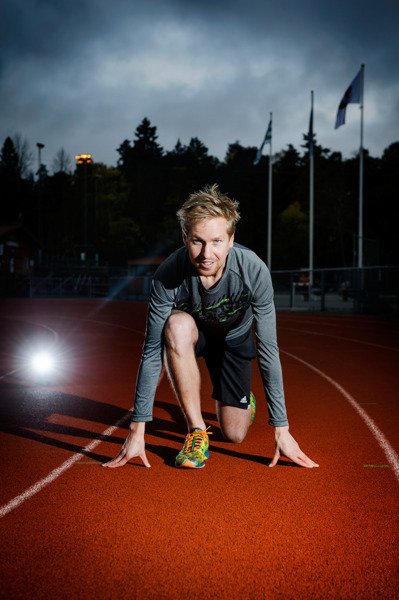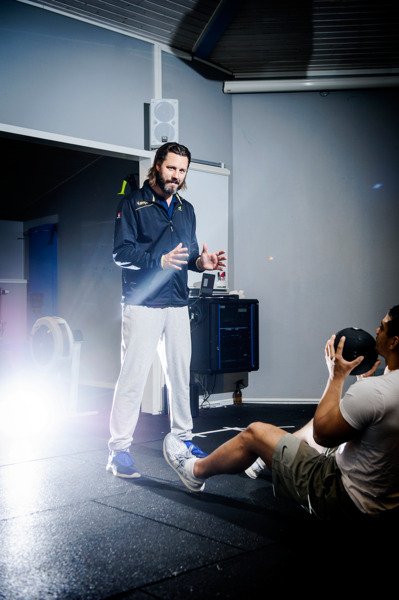Three researchers: Safe sport their goal
Exercise has many positive effects. But top athletes also risk injuries. Meet three researchers who know which sports are the most risky, and how best to avoid injury.
The injuries made me depressed
Pilip Von Rosen, Post Doc at the Department of Neurobiology, Care Sciences and Society.
Researching into: Injury among young elite athletes

“I run once or twice a day, but have stopped competing. Before, when I competed in long-distance running at the elite level, I occasionally still got injured. Actually, I’ve only had a few strain injuries in my Achilles tendon and a tear in the back of the thigh, but the injuries made me depressed as I couldn’t run for four to five weeks. I thought it was unfair that I was injured, and didn’t know what to do with all my free time.
Even though we have many young people involved in sports activities at a high level, we lack numbers for how many are injured and how the injury affects them. I wanted to study this, and therefore we followed around 700 elite young athletes at the national sports high schools for one to two years. The risk of injury was higher than I had thought. High self-esteem and good sleep are protective factors but as many as 3 in 10 were injured every week, and many had problems that lasted a long time. Of the 16 types of sports we looked at, track and field athletics had the second highest risk of injury immediately after handball.
The identity of young elite athletes is often based on that of being an athlete, and I saw that some young people became uncertain about who they were when they were injured. They could even consider stopping elite sports and felt guilt, frustration and anger over being injured. I recognise this myself from when I was injured when I was young. What worries me is that we do not have proper strategies for helping these young people. Therefore, the National Sports High Schools need medical teams who know about the consequences of injury, and to whom the youngsters can turn for help.”
Wants girls to be able to live their dreams
UlrikaTranæus, Postdoc at the Department of Environmental Medicine, is also involved in the KI Musculoskeletal & Sports Injury Epidemiology Centre, and at GIH.
Researching into: How we can prevent injury among young girl football players and other athletes.

“At the moment, I have an injured cruciate ligament. The accident happened on holiday, but previously I have injured the ligament when fencing, which I do a lot. Cruciate ligament injuries are otherwise very common in football. I am researching into how we can help athletes stay injury-free. Now I am studying the injury risks among young female football players aged 13 to 19 years, who play on academy teams. They have to stay injury-free so that they have a chance of being accepted for the national team. We are following 600 girls for 52 weeks by asking questions about injuries, how much they play, and whether they find anything stressful. In this way we hope to identify risk factors and to help young female football players so that they can live their dream and reach their goal. I hope that my previous experience as a naprapath and sports psychology advisor in various national teams will enable me to make my research understandable and useable for the trainers.
I am interested in stress and tiredness as risk factors for injury, partly stress over time, but also how daily concerns can affect focus. I consider sports psychology to be a forgotten area. My previous research focussed on indoor bandy players who didn’t always find it easy to combine a full-time job with playing indoor bandy at the elite level. To prevent stress among the players, we gathered together the entire team and coached them in what stress is and how, via coping strategies, they could forget jobs and private lives when they are in the rink. Later, we saw that the number of injuries per team did in fact fall for those teams that had received coaching.”
I injured my shoulder
Martin Asker, Post Doc at the Department of Environmental Medicine.
Researching into: How we can prevent strain injuries in handball-playing teenagers.

Handball is one of the most injury-riddled sports among young people. The injuries occur all over from head to toe, but the knees, shoulders, fingers and feet are the most exposed. I injured my shoulder when I played ice hockey at elite level. In the end, I was forced to stop because the shoulder had dislocated too many times. The dream of becoming an ice-hockey professional was over, but instead I became interested in working within sports.
First, I trained to be a masseur and then a naprapath, and now I work with young elite handball players. And in my research, I am focussing on the shoulder. We have followed 471 players at ten handball sports high schools. Of these, 44 percent reported problems with their shoulders at some time during the season. Half of these had significant problems which affected training, performance or number of matches played. Most of those who had significant problems with their shoulders also had problems the following season. Shoulder problems in handball players are thus relatively persistent.
Because handball is an intensive and tough contact sport, there is always the risk of injury. But, we have a good chance of reducing the risk of strain injuries, and my goal is to primarily decrease exactly this type of injury in handball players. We have already identified some risk factors and seen that players in certain positions have a higher incidence of shoulder problems, and we have also seen that girls have more problems than boys. The plan now is to start a study in which we evaluate a training programme intended to strengthen the shoulder. I believe that reducing the number of strain injuries can help players to maintain motivation.
As told to Maja Lundbäck, first published in the magazine "Medicinsk Vetenskap", no 4, 2017.
